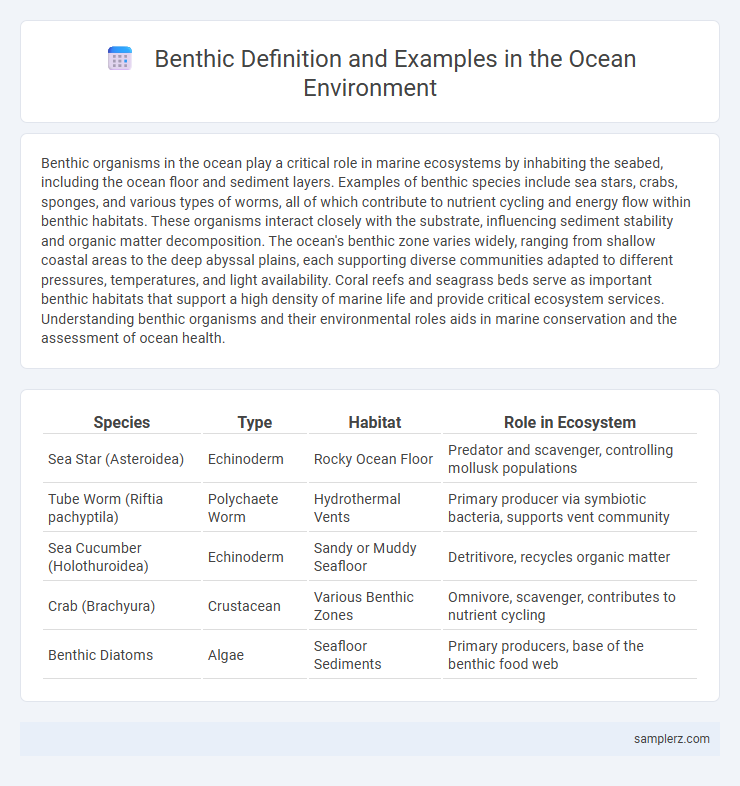Benthic organisms in the ocean play a critical role in marine ecosystems by inhabiting the seabed, including the ocean floor and sediment layers. Examples of benthic species include sea stars, crabs, sponges, and various types of worms, all of which contribute to nutrient cycling and energy flow within benthic habitats. These organisms interact closely with the substrate, influencing sediment stability and organic matter decomposition. The ocean's benthic zone varies widely, ranging from shallow coastal areas to the deep abyssal plains, each supporting diverse communities adapted to different pressures, temperatures, and light availability. Coral reefs and seagrass beds serve as important benthic habitats that support a high density of marine life and provide critical ecosystem services. Understanding benthic organisms and their environmental roles aids in marine conservation and the assessment of ocean health.
Table of Comparison
| Species | Type | Habitat | Role in Ecosystem |
|---|---|---|---|
| Sea Star (Asteroidea) | Echinoderm | Rocky Ocean Floor | Predator and scavenger, controlling mollusk populations |
| Tube Worm (Riftia pachyptila) | Polychaete Worm | Hydrothermal Vents | Primary producer via symbiotic bacteria, supports vent community |
| Sea Cucumber (Holothuroidea) | Echinoderm | Sandy or Muddy Seafloor | Detritivore, recycles organic matter |
| Crab (Brachyura) | Crustacean | Various Benthic Zones | Omnivore, scavenger, contributes to nutrient cycling |
| Benthic Diatoms | Algae | Seafloor Sediments | Primary producers, base of the benthic food web |
Understanding Benthic Zones in the Ocean
Benthic zones in the ocean consist of the ecological regions at the lowest level of a body of water, including the sediment surface and sub-surface layers. Examples of benthic organisms include sea stars, crabs, sponges, and polychaete worms, which play crucial roles in nutrient recycling and energy flow within marine ecosystems. Understanding these zones helps reveal the complex interactions between organisms and their environment, contributing to ocean health and biodiversity conservation.
Key Characteristics of Ocean Benthic Environments
Ocean benthic environments are characterized by their location on or near the seafloor, encompassing diverse habitats such as coral reefs, deep-sea vents, and continental shelves. These environments exhibit limited light penetration, varying pressure conditions, and sediment types ranging from sandy to muddy substrates. Key ecological features include specialized benthic organisms adapted for substrate attachment, nutrient cycling, and survival in low-oxygen conditions.
Common Benthic Organisms Found in Oceans
Common benthic organisms found in oceans include polychaete worms, crustaceans such as amphipods and crabs, and various species of mollusks like clams and snails. These organisms play a crucial role in nutrient cycling and sediment stabilization on the ocean floor. Sponges and sea stars also contribute to benthic biodiversity, supporting complex marine ecosystems.
Role of Sea Stars in Benthic Ecosystems
Sea stars play a critical role in benthic ecosystems by regulating the population of mussels, which helps maintain species diversity on the ocean floor. Their predation prevents mussel dominance, promoting habitat complexity and supporting various marine organisms. As keystone predators, sea stars influence nutrient cycling and energy flow within benthic communities.
The Importance of Sea Cucumbers as Benthic Examples
Sea cucumbers play a critical role in maintaining ocean floor ecosystems by recycling nutrients and breaking down detritus, which enhances sediment quality. Their bioturbation activities increase oxygen penetration in the benthic zone, supporting diverse marine life and stabilizing the habitat. As key benthic organisms, sea cucumbers contribute significantly to nutrient cycling and overall ocean health.
Benthic Crustaceans: Crabs and Lobsters in the Ocean
Benthic crustaceans such as crabs and lobsters play a crucial role in ocean ecosystems by contributing to nutrient cycling and sediment turnover on the seafloor. These species inhabit diverse habitats ranging from shallow coastal waters to deep-sea environments, adapting to various substrate types including sandy, muddy, and rocky bottoms. Their ecological functions support benthic community structures, enhance marine biodiversity, and influence the overall health of oceanic habitats.
Marine Worms: Vital Benthic Inhabitants
Marine worms, including polychaetes and nematodes, play crucial roles in benthic ecosystems by facilitating nutrient cycling and sediment aeration. These benthic invertebrates contribute to the decomposition of organic matter, enhancing the ocean floor's health and biodiversity. Their burrowing activities promote oxygen penetration, supporting diverse microbial communities essential for maintaining ecological balance.
Sponges and Corals: Stationary Benthic Life
Sponges and corals represent key examples of stationary benthic organisms thriving on the ocean floor, forming complex habitats that support marine biodiversity. Sponges filter vast volumes of water, playing a crucial role in nutrient cycling and maintaining water quality, while corals build calcium carbonate skeletons that create reef structures essential for sheltering numerous marine species. These stationary benthic communities contribute significantly to the health and stability of marine ecosystems by fostering rich biological interactions and sustaining diverse aquatic life.
How Benthic Organisms Support Ocean Health
Benthic organisms, such as sea cucumbers, polychaete worms, and corals, play a crucial role in maintaining ocean health by recycling nutrients and breaking down organic matter on the seafloor. Their activities enhance sediment stability and promote biodiversity, creating habitats for various marine species. These processes help regulate carbon cycles and improve water quality, ultimately supporting the overall productivity of marine ecosystems.
Threats Facing Benthic Communities in Modern Oceans
Benthic communities, including coral reefs, seagrass beds, and deep-sea sponge fields, are facing significant threats from ocean acidification, rising temperatures, and bottom trawling practices. These stressors disrupt sediment composition and oxygen levels, leading to habitat degradation and loss of biodiversity critical for marine ecosystems. Pollution from microplastics and toxic chemicals further exacerbates the vulnerability of benthic organisms, undermining their ecological roles in nutrient cycling and carbon sequestration.

example of benthic in ocean Infographic
 samplerz.com
samplerz.com